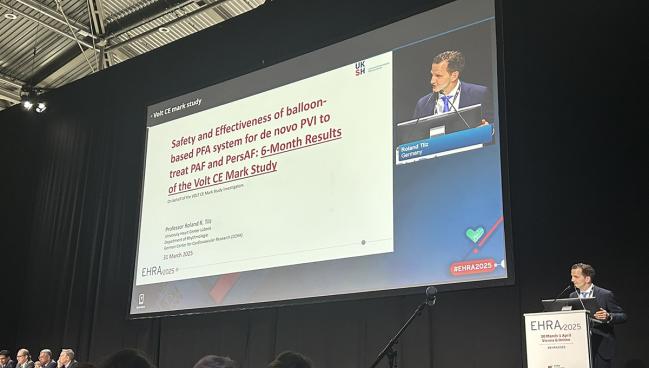Positive Results With Volt Pulsed-Field Ablation System
The system, which has received CE Mark approval in Europe, adds to an increasingly crowded field of PFA technologies.

VIENNA, Austria—The Volt pulsed-field ablation (PFA) system (Abbott) is safe and effective for pulmonary vein isolation in patients with atrial fibrillation (AF), according to results from the VOLT CE Mark study.
Acute isolation was achieved in 99.1% of treated veins and freedom from documented atrial arrhythmias at 6 months was observed in 88.2% and 76.7% of patients with paroxysmal and persistent AF, respectively, Roland Tilz, MD (University Hospital Schleswig-Holstein, Lübeck, Germany), reported recently here at the European Heart Rhythm Association Congress 2025.
There were four serious safety events within the first 7 days (2.7%), including two vascular access-site complications, one cardiac tamponade, and one case of pneumonia requiring hospitalization (deemed unrelated to the procedure). There were no deaths or cases of phrenic nerve injury, clinically significant hemolysis, acute renal failure, or coronary artery spasm.
The data, which were published simultaneously online in EP Europace, are “predictive of a favorable 12-month clinical outcome,” Tilz said during his presentation, noting that the clinical information will be presented at the annual meeting of the Heart Rhythm Society later this month.
Additional insights into the performance of the Volt PFA system, which received CE Mark approval in Europe last month, will come from the VOLT-AF investigational device exemption trial. That study completed enrollment last year, with Abbott saying that it expects to release 12-month follow-up later in 2025.
VOLT CE Mark Study
The Volt system consists of a balloon-in-basket design, which allows optimal balloon-to-tissue contact. It also provides better energy transmission into the myocardium and less transmission into the blood, which reduces the likelihood of hemolysis and other collateral damage, Tilz said. Volt has a fully integrated 3D mapping system and contact-sensing capabilities.
The VOLT CE Mark study, conducted at 11 sites, enrolled 150 patients with symptomatic, recurrent, drug-refractory, paroxysmal or persistent AF; 146 (mean age 64 years; 63% men), of whom most had paroxysmal AF, underwent ablation with the Volt system.
Primary safety events occurred in 2.7% of patients within 7 days.
Acute effectiveness was defined as isolation of the pulmonary veins confirmed after a 20-minute waiting period. Nearly all patients (98.6%) had all their pulmonary veins isolated, with a 97.6% rate of first-pass isolation.
Effectiveness of the procedure at 6 months was assessed as the proportion of patients free from documented atrial arrhythmia recurrence or acute failure, cardioversion, repeat procedure, or the need for new or increased class I/III antiarrhythmic drugs, with or without documented arrhythmia recurrence. This was achieved in 86.2% of patients with paroxysmal AF and 72.1% of those with persistent AF.
Seven patients required repeat ablations by 6 months, and in six of these cases, operators performed remapping. This showed that 82.6% of originally isolated veins remained isolated. And in the four repeat procedures that occurred after the initial 3-month blanking period, 14 of 15 originally isolated veins remained isolated.
Eyeing the Costs of PFA
The discussant for the trial, Carlos Morillo, MD (Libin Cardiovascular Institute, University of Calgary, Canada), pointed out some limitations of the study, including the observational design, small sample size, and lack of a comparator group. In addition, he said, “we didn’t hear anything about the learning curve, which probably is there.”
Acute effectiveness was “pretty good,” Morillo said. “All these veins seem to be isolated, but I’m not sure what [it means] to remap after we do a blast with PFA—if it’s useful or not. I don’t think we have enough data to know what that means.”
Effectiveness at 6 months also appeared satisfactory, he said.
As the PFA field develops, “the problem we’re having now is that we have a lot of options,” Morillo said, noting that it’s unclear which one is best.
In that context, the Volt system is “added technology to our toolbox that’s getting pretty crowded,” he said. “And the thing that we will need to see is that these are expensive technologies, and we will need to figure out how do we pay for all these.”
Todd Neale is the Associate News Editor for TCTMD and a Senior Medical Journalist. He got his start in journalism at …
Read Full BioSources
Tilz RR, Chierchia GB, Gunawardene M, et al. Safety and effectiveness of the first balloon-in-basket pulsed field ablation system for the treatment of atrial fibrillation: VOLT CE mark study 6-month results. EP Europace. 2025;Epub ahead of print.
Disclosures
- The Volt PFA system and the study were sponsored by Abbott.
- Tilz reports consulting for Boston Scientific, Philips, Medtronic, Biosense Webster, Abbott Medical; receiving speaking honoraria from Boston Scientific, Biotronik, Biosense Webster, Abbott Medical, Lifetech, and Pfizer; receiving research grants from Abbott, Biotronik, Medtronic, Biosense Webster, and Lifetech; and receiving travel grants from Abbott, Biosense Webster, Boston Scientific, Medtronic, and Philips.
- Morillo reports research contracts from Novartis and other relationships with Medtronic, Boston Scientific, Kardium, and Novartis.





Comments